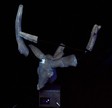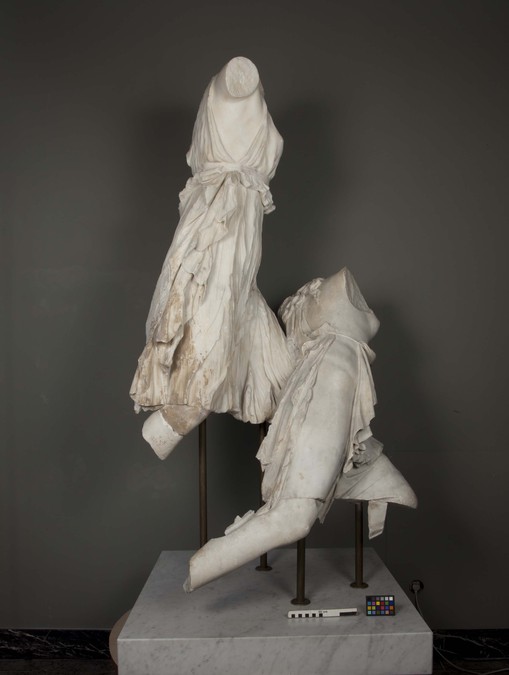Statue group of Artemis and Iphigenia
Summary
The Artemis- and Iphigenia group including a hind shows an interesting colour scheme including the use of gilding. Both female torsos have red pigments on garments, hair and skin. Also, the head of the hind has remains of red. X-ray fluorescence analysis identifies iron (Fe). The torso at the back, representing the goddess Artemis, carries a delicate and transparent purple coloured layer on the chiton and the exposed right knee. Analysis of the purple ground by means of X-ray fluorescence (XRF) shows a content of iron (Fe) and Mercury (Hg) indicating a colour mixture of cinnabar and ochre.On top of the purple layer minute traces of gild have been identified. Scattered particles of Egyptian blue have been identified by means of VIL on the upper part of the back of the Goddess’ chiton.
Description of object
What remains of the sculpture group are the torsos of two females. The torso at the back is the Goddess Artemis. Over the bust crossed bands held together by a buckle have been the support for a quiver of arrows on the back. However, the quiver is today lost. The goddess is dressed in a chiton clinging closely to the body. In front the torso of a half-lying woman is Iphigenia. The woman’s chiton is ripped aside exposing the right breast, hips and right leg. Also belonging to the group but mounted seperately are the remains of the head of a deer. Several minor fragments belonging to the sculpture group are stored seperately.
Choice of methods
Visual examination
- Macroscopic
- Microscopic in situ
Technical imaging
- UV
- VIL
Sampling
- XRF
Visual examination
On the torso in the background remnants of a transparent, purple layer is found on the chiton covering bust and abdomen and on the belt and belt buckle. The same purple colour is also identified on the sculptures exposed right knee. Minute fragments of gold are found on top of the purple layer on both the abdomen and on the knee. A scattered distribution of red grains is observed on both front and back of the sculture and on exposed skin areas and as well as on the garments. The grains are usually preserved in the calcareous crusting on the surface of the marble.
The torso in the foreground shows remains of red and orange-red colour on the garments. On exposed skin parts red grains are found on the right breast, right leg and on the back of the sculpture. The curly hair preserved on the back of the sculpture has a scattered distribution of red colour.
The head of the hind has scattered particles of red on mouth, fur and antlers. Along the rim of the eyes of the animal a fine black line is observed.
Technical imaging
UV-FL: The sculpture group reveals no fluorescence phenomena related to the antique polychromy . However, retouched plaster fillings and surface degradations on both garments and exposed skin parts of the torsos and on the head of the hind stand out.
VIL: Only the standing torso in the background shows spatially the presence of luminescent particles. On the back of the sculpture scattered grains shining bright white are observed on the upper part of the chiton and below the belt indicating the use of Egyptian blue.
Other types of investigation
XRF: Measuring point 01: Analysis shows a content of gold (Ag), mercury (Hg), iron (fe), silver nitrate (Ag NO3) and strontium (Sr). Measuring point 02:Analysis shows a content of gold (Ag), mercury (Hg), iron (fe) and silver nitrate (Ag NO3). Measuring point 03: Analysis shows a content of mercury (Hg), iron (Fe), silver nitrate (AgNO3) and strontium (Sr). Measuring points 04 and 05: Analysis shows a content of silver nitrate (agNO3) and strontium (Sr).
Bibliography
F. Poulsen (1951), Catalogue of Ancient Sculpture in the Ny Carlsberg Glyptotek. Copenhagen: Cat. Nr. 83-83a.
A.M. Nielsen and J.S. Østergaard (1997), Catalogue. The eastern Mediterranean in the Hellenistic Period, Ny Carlsberg Glyptotek, Copenhagen, cat. no. 12.
M.L. Sargent & R.H. Therkildsen (2010), The Technical Investigation of Sculptural Polychromy at the Ny Carlsberg Glyptotek 2009–2010 – An Outline, in J.S. Østergaard (ed.) Tracking Colour. The Polychromy of Greek and Roman Sculpture in the Ny Carlsberg Glyptotek, Preliminary Report 2, Copenhagen, 11-26. Download.
- IN 481 - 482a
- Statue
- c.. 3rd-1st B.C.E.
- Hellenistic
- White marble
- Acquired in Rome in 1888.
- H. 17.5 cm.; W. 83.5 cm.; D. 90 cm.


















